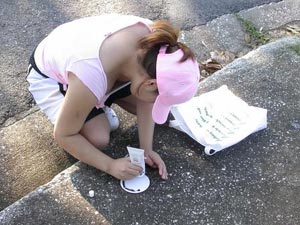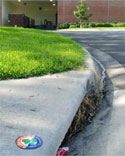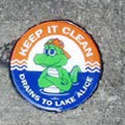Storm Drain System: Labels
What is storm drain labeling?
Storm drain labeling involves marking storm drain openings with messages reminding citizens not to dump pollutants down the drains.
Drain messages are usually a simple phrase to remind passersby that the storm drains connect to local waterbodies and that dumping in drains pollutes these waters. Sometimes, the drains specify the body of water where drain water eventually flows. Common messages include "No Dumping. Drains to Water Source," "Drains to River," and "You Dump it, You Drink it. No Waste Here."
UF storm drain labels have a simple message: "Keep it Clean."
Storm labels most commonly appear in two forms: stenciled painted messages, or permanent signs of aluminum, ceramic, plastic or other durable materials. Each form of labeling has its own advantages and disadvantages, but both convey the same thought.
Does storm drain labeling work?
According the Environmental Protection Agency, "regardless of the condition of the waterbody, the signs raise awareness about the connection between storm drains and receiving waters and they help deter littering, nutrient overenrichment, and other practices that contribute to nonpoint source pollution… stenciling projects offer an excellent opportunity to educate the public about the link between the storm drains system and drinking water quality."(1)
Measuring the precise effect that storm drain marking has on human behavior is difficult. It is not easy to measure reductions in specific components of urban runoff, as nonpoint source pollution is diffuse in origin by definition.
Ways to Measure the Effectiveness of Markers
Surveys
One of the best ways to determine whether the markers are changing community behavior is to ask the residents of the community if they have seen them, if they understand the connection between storm drains and local waterbodies, and if they have changed any behaviors as a result of the markers. Surveys can be conducted both before and after labeling to get a more accurate reflection of behavior changes as a result of storm drain labeling.
The University of Wisconsin Cooperative Extension Service conducted a survey in two Wisconsin neighborhoods, one that had stenciled storm drains and one that did not have stenciled storm drains. Their results showed there is a significant difference in understanding the relationship between storm drains and waterbodies between those who had seen the markers and those who had not. "For example 71 percent of the people who said they had seen the stenciled message knew that storm drain pipes lead directly to the nearest water body. Only 40 percent of those who had not seen the storm drain stencil said they knew storm drains empty to the nearby lake."(2)
Survey results also showed that labeling storm drains raised awareness in a broader area than just the intended neighborhood.
The Wisconsin Extension survey also concluded "all survey respondents indicated that stenciled messages were more influential that television, direct mail, conversations with neighbors and/or conversations with agency representatives in raising awareness of general storm water issues."
Water Quality Sampling
The effectiveness of storm drain markers can also be assessed by periodically examining water samples from places where storm drains empty into water bodies. If the level of pollutants in these areas is significantly reduced after the drains have been marked, it can be assumed that the labeling may have had a deterrent effect.
Increase in Properly Disposed Waste
Communities also can monitor the volumes of used motor oil and paint delivered to proper recycling centers. If significantly more volumes of these hazardous substances are being properly disposed of following a storm drain marking event, the markers could be partially responsible for the change in behavior.
Number of Drains Stenciled and Number of Volunteers Involved in Labeling
Some municipalities measure success in terms of how many storm drains are labeled and the number of volunteers and volunteer groups involved in participating in the labeling.
Who uses storm drain markers?
The Environmental Protection Agency recommends the use of storm drain markers as part of it's NPDES education and outreach programs. Many communities across the country and particularly across Florida, have made them an important part of their non-point source pollution campaigns.
In addition to the University of Florida and the City of Gainesville, the following municipalities are just a sample of those that use storm drain labels:
- Alachua County
- Brevard County
- Hillsborough County
- Volusia County
- Indian River Lagoon
- Tampa Bay
- Orlando
References
- Environmental Protection Agency. 2010. "Public Involvement and Participation: Storm Drain Marking."
Last updated on November 10, 2010. - University of Wisconsin - Extension. 1999. "Storm Drain Stenciling: Impacts on Urban Water Quality."




